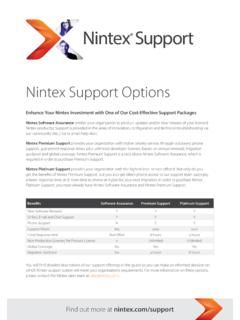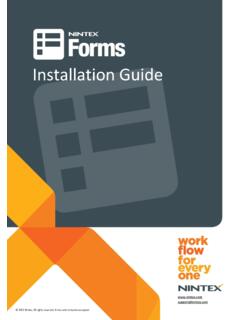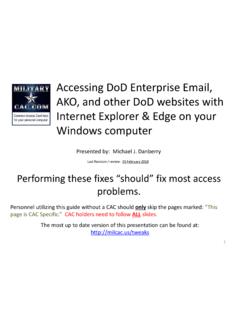Transcription of Nintex Workflow 2013 Installation guide
1 Nintex Workflow 2013 Installation guide Back to Contents 1 | Nintex Workflow 2013 Installation guide 2013 Nintex . All rights reserved. Errors and omissions excepted. Nintex Workflow 2013 Installation guide Back to Contents 2 | Table of Contents System Requirements .. 3 1. Installing Nintex Workflow 2013 .. 4 Before running the Installer .. 4 Run the Installer .. 4 Deploy the Solution Package .. 4 Installing Nintex Workflow 2013 Backwards Compatibility UI Features (optional) .. 5 Installing Nintex Workflow 2013 Enterprise Features (optional) .. 5 Importing the License .. 5 2. Database Configuration .. 6 Configuring the Database .. 6 Adding a Content Database (optional).
2 6 3. Configure Nintex Workflow 2013 Server Settings .. 6 Web Application Activation .. 6 Enable Nintex Workflow 2013 Workflow Actions .. 6 Configuring Email Settings .. 6 Enabling and Configuring LazyApproval (optional) .. 7 4. Nintex Live .. 7 Establishing a Connection to Nintex 7 Enabling Nintex Live for Nintex Workflow .. 7 5. Activate Features .. 8 Site Collection 8 Site Activation .. 8 Appendix A: Notes on SharePoint services required to run workflows .. 9 Nintex Workflow 2013 Installation guide Back to Contents 3 | System Requirements Operating System Nintex Workflow 2013 must be installed on Microsoft Windows Server 2008 R2 or Windows Server 2012. Browser Client Microsoft Internet Explorer although Microsoft Internet Explorer 9 or greater is recommended.
3 Software Nintex Workflow 2013 requires that the following software is installed and correctly configured: Microsoft SharePoint Foundation 2013 or Microsoft SharePoint Server 2013 SQL Server 2008 R2 SP1 or SQL Server 2012. Nintex Workflow 2013 Installation guide Back to Contents 4 | 1. Installing Nintex Workflow 2013 Before running the Installer To help ensure Nintex Workflow 2013 installs successfully: a) We recommend disabling UAC (User Account control), as this may prevent you from installing Nintex Workflow 2013 successfully. See here for information on how to do this. b) Ensure you are logged into the server with the SharePoint Farm Installation account. Note: For information on SharePoint account permissions and security settings, please see here.
4 Run the Installer 1. Double click the installer file (exe) and click Next . 2. Read the End-User License Agreement. You must select I Agree for the Installation to proceed. Click Next . 3. Select whether you want to install Nintex Live. This will install the Nintex Live Framework and certificates required to enable connectivity to Nintex Live. Note: If an older version of Nintex Live is installed and the checkbox to install Nintex Live is not checked, Nintex Live will be automatically upgraded. Note: To use Nintex Live, please refer to Nintex Licensing Information on For more information on Nintex Live configuration, refer to section 4. Choose whether you want to add the solution to SharePoint now (recommended) or export it for manual deployment later using SharePoint PowerShell.
5 Click Next . Note: Nintex Workflow 2013 does not create an Installation folder in the Program Files directory. Choosing to export the solution provides access to the various solution files for manual deployment. 5. The installer will inform you it is ready to proceed. Click Next . 6. Click the Close button. SharePoint Central Administration will have loaded in the background. Deploy the Solution Package 1. Navigate to Central Administration and click on System Settings . 2. Click on Manage farm solutions in the Farm Management section. The solution should be visible. You will also see two additional solutions: you should only deploy this if you intend to perform a database attach upgrade from SharePoint 2010; you should only deploy this if you have been licensed for the Enterprise version.
6 3. Click the link and then click Deploy Solution in the toolbar. 4. Ensure that All content Web applications is selected in the Deploy To? section. Click OK . 5. After a short interval, you will be returned to the Solutions Management page. Nintex Workflow should now appear as Deployed . Nintex Workflow 2013 Installation guide Back to Contents 5 | 6. Repeat steps 3-4 and deploy again. Select your Central Administration web application as the Deploy To? location. Installing Nintex Workflow 2013 Backwards Compatibility UI Features (optional) 1. Navigate to Central Administration and select System Settings . Click on Manage farm solutions . 2. Click link and then click Deploy Solution in the toolbar.
7 3. Ensure that All content Web applications is selected in the Deploy To? section. Click OK . 4. After a short interval, you will be returned to the Solutions Management page. should now appear as Deployed . Installing Nintex Workflow 2013 Enterprise Features (optional) 1. Navigate to Central Administration and select System Settings . Click on Manage farm solutions . 2. Click link and then click Deploy Solution in the toolbar. 3. Ensure that All content Web applications is selected in the Deploy To? section. Click OK . 4. After a short interval, you will be returned to the Solutions Management page. should now appear as Deployed . 5. Repeat steps 2-3 and deploy again.
8 Select your Central Administration web application as the Deploy To? location. Note: This is required to run the administration reports via SharePoint Central Administration. Importing the License For full product functionality you must have a license file issued by Nintex . The license can be either a full production license or an evaluation license. The license file will need to be imported into SharePoint Central Administration. 1. Navigate to Central Administration and select Nintex Workflow Management . Click Licensing . 2. Click the Import button. 3. Click Browse to locate your license file. Once it has been located, click Import . 4. The Licensing information will then be displayed.
9 Click OK . You can now proceed to configure databases for Nintex Workflow 2013 . Nintex Workflow 2013 Installation guide Back to Contents 6 | 2. Database Configuration Configuring the Database 1. Navigate to Nintex Workflow Management and click Database setup . 2. Click the Create button in Configuration Database . 3. Enter the name of your database server and a database name. Note: The Database Server will default to the default SharePoint database server. Note: Nintex Workflow 2013 can use multiple databases, one for configuration and others for content. By default the configuration database is also made the content database. You can add more databases if required. 4. Click OK.
10 Note: In small farm scenarios it is reasonable to use the same database for the content and configuration databases. By adding multiple content databases Nintex Workflow 2013 can automatically distribute the workflows within each site collection to their separate content databases to help spread the load. Adding a Content Database (optional) 1. Navigate to Central Administration and click on Nintex Workflow Management . Select Database setup . 2. Click Add content database in the Content Databases section. 3. Repeat steps 3 and 4 in section 4. In the Configuration Databases section, you will now see two content databases connection strings. 3. Configure Nintex Workflow 2013 Server Settings Web Application Activation 1.












![]khWj ed =k Z[ - Medical University of South Carolina](/cache/preview/4/9/3/1/6/0/0/4/thumb-49316004a0f860b7ac2e6396811629fe.jpg)



